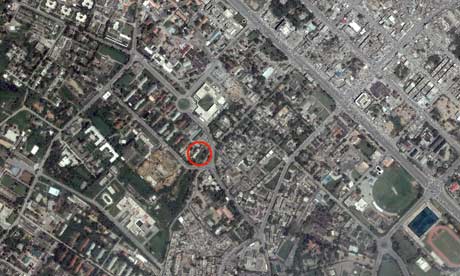
Revealed: torture centre linked to MI5
Ian Cobain
The centre, run by the country's Inter-Services Intelligence agency (ISI), is in the Saddar district of Rawalpindi. It is surrounded by high walls and watchtowers, and bristling with surveillance cameras.
So notorious is the ISI that local photographers are reluctant to take pictures of the centre, although satellite images are readily available.

An aerial photograph of Rawalpindi showing the interrogation centre. Photograph: Getty Images
A British citizen says he was driven there in 2004, held for 10 months and tortured. Salahuddin Amin, now aged 33, had moved to Pakistan three years earlier from Luton, Bedfordshire.
Amin was eventually returned to the UK and successfully prosecuted. His trial heard that he was interviewed by officers from the British security service MI5 several times during his detention. His lawyers allege ISI officers beat and whipped him, and threatened him with an electric drill, in between the MI5 interviews, and that the British officers must have known he was being mistreated.
A second British citizen, aged 33 and from Manchester, who was arrested at the request of British authorities, is thought to have been held at the same place. The man, who cannot be named for legal reasons, has described being hooded and driven to a detention centre that resembles Amin's account. He was deprived of sleep and whipped, the man says, and an ISI officer used pliers to pull out three fingernails from his left hand. He says he was then interviewed by two British officials. His lawyers suspect they were from MI5.
Two other British citizens have said they were tortured by the ISI before being questioned by British counter-terrorism officials. Lawyers say there is evidence MI5 instigated the torture of British citizens or, at very least, turned a blind eye to their mistreatment. Last month, the Guardian disclosed how the allegations are to be aired in forthcoming court cases, including a terrorism trial, a criminal appeal and a civil action being pursued by one of the alleged victims.
MI5 declined to comment, but pointed to evidence given to the all-party intelligence and security committee about training it gives its agents regarding the possible mistreatment of detainees by foreign intelligence agencies. Guidance for officers questioning detainees held overseas states: "The security and intelligence agencies do not participate in, solicit, encourage or condone the use of torture or inhuman and degrading treatment."
Amin says he was one of several prisoners kept in an underground block of 10 small cells, each with a mattress and a pillow. The torture, he says, took place nearby in a carpeted room with bright overhead lights, a table, several chairs and a small wooden stool where prisoners were expected to sit. In one corner of the room was a camera. He says that sometimes he would be hooded and driven for 20 minutes to meet two MI5 officers; on other occasions they would question him in the room where he had been tortured.
Among other people thought to have been tortured at the Rawalpindi centre is an innocent taxi driver who was caught up in the investigation of Amin. Ezaj Rabanni, 38, was interrogated for several days about the whereabouts of Amin, who had been his passenger several times and whom the ISI had been unable to locate.
"They beat me for half an hour or so on the first day and they whipped me with a leather belt," Rabanni said in a statement taken before Amin was tried at the Old Bailey. "I couldn't see them because I had a hood over my head the whole time. They kept asking me about Salahuddin, asking me where he was. They beat me the second day and the third day. I couldn't protect myself - my hands were shackled behind my back the whole time.
"Then I heard the sound of an electric drill being switched on. I could feel the drill touching my side and my clothes being wrapped around it. I have never been so frightened in my life."
Rabanni gave evidence at the Old Bailey trial that ended with Amin and four other men being jailed for life for conspiring to cause explosions in the UK. The taxi driver now says he is too terrified to return to Pakistan, because he fears he may be arrested and tortured again because of what he said in court. He has applied for asylum and is living in Stockton-on-Tees, Cleveland.
Questions are likely to be asked about the role of the Foreign Office, as consular officials tried to visit only two of the detainees. The men's lawyers say consular officials must also have been aware of the detention of each of them, and known there was a strong possibility they were being tortured.
Asked about this failure, the Foreign Office said it could not act for British citizens of joint British-Pakistani nationality, as the authorities in Islamabad regarded them as being only Pakistani.
However, the Foreign Office does act on behalf of the more than 200 young people of dual nationality forced into marriage in Pakistan each year. It has five people working full-time on such cases.
Ali Dayan Hasan, the south Asia researcher for Human Rights Watch, said: "I find it worrying that the British high commission has sought refuge behind the dual citizenship clause when it knows that the detainee's life may be in danger and that the detention is illegal under Pakistani, British and international law."
The Foreign Office would not say how many British citizens have been detained in Pakistan in the last decade and questioned over alleged terrorism. Nor would it disclose how many had subsequently complained of mistreatment, saying: "We have a duty to respect the privacy of the individuals concerned."
Asked how many complaints of mistreatment had led to investigations by British authorities, the Foreign Office replied: "None. The British authorities are not able directly to investigate the conditions in Pakistani institutions."
www.guardian.co.uk/world/2008/may/12/terror.centre/print
